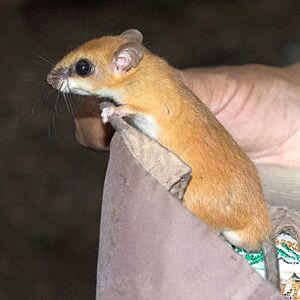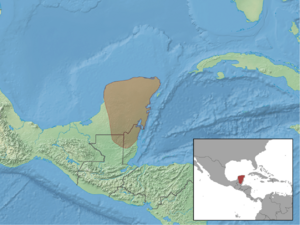Hatt's vesper rat facts for kids
Quick facts for kids Hatt's vesper rat |
|
|---|---|
 |
|
| Conservation status | |
| Scientific classification | |
| Genus: |
Otonyctomys
|
| Species: |
hatti
|
 |
|
The Hatt's vesper rat (Otonyctomys hatti) is a small rodent that lives in Central America. It is also known as the Hatt's vesper mouse or the Yucatán vesper rat. This animal is the only species in its group, called a genus, which is named Otonyctomys. It was named after Robert T. Hatt, the person who discovered it.
What Does Hatt's Vesper Rat Look Like?
Hatt's vesper rat looks like a typical rat. It is quite similar to another rat called Sumichrast's vesper rat. The easiest way to tell them apart is by looking at their ears. Hatt's vesper rat has much larger ear bones, which are called auditory bullae.
This rat is fairly small. Its head and body are about 9 to 12 centimeters (3.5 to 4.7 inches) long. It also has a long tail, which can be 6 to 13 centimeters (2.4 to 5.1 inches) long. Adult rats usually weigh between 23 and 36 grams (0.8 to 1.3 ounces).
The fur of the Hatt's vesper rat is very colorful. It is bright reddish-brown or yellowish on most of its body. Its belly is creamy or white. The rat has a short, rounded snout. It also has clear black marks in front of its eyes, reaching all the way to its whiskers. Younger rats are usually duller in color and have less shiny fur. The tail is covered with thick brown fur. However, its ears have very little hair. Female rats have four teats on their belly.
Where Does Hatt's Vesper Rat Live?
Hatt's vesper rat lives in the Yucatán Peninsula. This area includes parts of Mexico, northern Guatemala, and Belize. In Mexico, it can be found in the states of Campeche, Yucatán, and Quintana Roo.
These rats prefer to live in tropical forests with broad leaves. They like areas that are close to water and are not very high up, usually below 250 meters (820 feet) in elevation. People have often seen them in trees or climbing vines called lianas. They have also been found on fallen wood or even inside the roofs of houses. This suggests that they might spend most of their time living in trees.
Hatt's Vesper Rat's Life and Habits
Not much is known about Hatt's vesper rat because it has not been studied a lot. As of 2008, scientists had only found eighteen specimens of this rat.
It seems that these rats are nocturnal, meaning they are active mostly at night. They are also herbivorous, which means they eat plants. Their diet includes seeds and fruits. They appear to spend a lot of their time in trees.
Scientists are not sure if the Hatt's vesper rat has a specific breeding season. However, one female rat caught in February was producing milk for babies, which is called lactation.
In Mexico, this rat is considered a threatened species. But the IUCN (International Union for Conservation of Nature) lists it as a species of least concern. This is because it seems to be spread out over a wide area and can adapt to different environments. Scientists have also found fossils of Hatt's vesper rats that date back to the Pleistocene era, which was a very long time ago.


